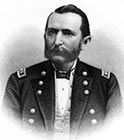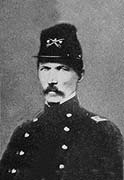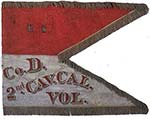The Battle of Bear River

Salt Lake City, Utah. February 7th, 1863.
In good faith, I promised to write to the Alta my own observations and study of institutions, men and manners in Utah: but finding that there was more to see and more to learn than I had anticipated, the anxiety to be reliable has week after week suggested delay. I would not now break the silence between us with the subject proposed for discussion as I am not confident of being fully in possession of the data, facts and figures to enable me to handle matters impartially: but as the unexpected engagement between our volunteers and the Indians will unquestionably be of deep interest to our readers, I propose to open our relationship from Utah with…
The Expedition
The rumored circumstances which gave rise to the expedition against the Indians are numerous and diversified: the civil part figuring in it being evidently desirous of a large share of the glory, to which they have as little claim, in reality, as if their immaculate greatness had been unknown in the land. The conception of the expedition is due to Colonel P. Edward Connor, and the brilliant execution of his plans and their glorious results are exclusively the well earned honors of his brave officers, and his no less brave men. Judge J.F. Kinney did certainly issue a writ for the apprehension of Indian Chiefs Sandpitch, Sagwitch and Bear Hunter, on the charge of murdering miners passing to and from this city and the new gold mines in Washington and Dakota Territories; and that writ was as certainly placed in the hands of Marshal Gibbs for legal service; but the volunteer expedition was not the Marshal's posse committals.
Colonel Connor from the first reports of the murder of immigrants of the Humboldt and various other localities along the Northern route to California last summer– determined in cutting off the savages, and commenced the carrying out of his design by the cavalry expedition from Ruby Valley last fall, in which Major McGarry was so very successful in the accomplishment of his commander's instructions, save and except in his inability to find trees on which to hang the murderous savages. Since that time, the Indians attacks upon the whites, traveling to and from the Dakota mines, have only added determination to determination to rid the country of this terrible scourge– this perpetual reign of terror; and wherever there was the slightest hope of reaching the savages, the gallant Major was ordered in pursuit. Twice, since the arrival of the Volunteers at Salt Lake, expeditions have been sent into the northern settlements of this territory– the first for the recovery of a white boy retained by the Indians, and the second for the recovery of immigrant property. From reliable information recently furnished Colonel Connor of the locality of the Indians who had been engaged in the murderous work for the last fifteen years, that the expedition was undertaken, the more recent attacks and murders only adding to the incentive to make clean work of the savages. Preparations for the expedition were in progress, when Marshal Gibbs called upon the Colonel for a military escort to protect him in serving the writs for the Indian chiefs named. The Colonel acknowledged no authority for calling on a military escort till a civil posse had been called, tried and failed; but at the same time informed the Marshal that he was prepared to start for that place, and would inform him of his intended departure the night preceding the time fixed, that he might accompany the expedition; but he could promise him no prisoners– it was not his intention to have any. This much, as a prelude, is not without its interest, as it will have its bearing on record, and will award to the sword instead of the ermine the initiation of a struggle that will eventuate in freeing the country of its foes.
On Thursday, February 22nd, Captain Samuel N. Hoyt, with forty men of company "K" accompanied by a train of fifteen wagons, taking with them two howitzers, left Camp Douglas with secret instructions,
secret so far as his duties, etc., were concerned, but public enough for the Indian runners
to know that the Camp on Bear River was the destination of the troops. Through the snow, the Infantry plodded along, till beyond the confines of the city on the west, where the train received the volunteers. Taking into account the recent snows, the northerly climate, and the road that would have to be made over the summit of the mountains separating Cache and Box Elder Valleys, the Infantry were to pursue their march leisurely, with the view also that the Indians might learn the strength of the Volunteers, and basing calculations thereon, would gather in their stronghold and have a battle. The ruse was successful. Two Indian boys, one of them in the service of a mountaineer, reached the Indian camp with the intelligence of the march, numbers, etc. The Indian chiefs were unconcerned, but gave orders for their warriors to prepare, while they visited, as usual, the settlements. On the morning of the sixth day's march, as Captain Hoyt and his men entered the town of Franklin, Bear Hunter left it. The same evening, after a four day's ride, one of sixty miles and the other of easier marches, over the mountains, in deep snow and with a piercing cold, bitter wind that nearly disabled a third of the command, Major McGarry, with two hundred cavalry, accompanied by Colonel Connor and his aids, at midnight rode into the settlement and fraternized with the infantry. The Indians could know nothing of the approach of any cavalry, and thus far the plan for their destruction had been successfully concealed. The infantry had orders to march at the first hours of the morning, and the cavalry to rest for a few hours. The unbroken roads impeded the progress of the infantry, and the heavy howitzers were clearly to fall in the rear; yet concealment being success, the cavalry dashed on at its appointed hour and reached the banks of Bear River before the dawn of day had fully illuminated the fields of contest.

The orders to dismount, load arms, mount and forward,
soon succeed each other, and Major McGarry– accompanied by Major Gallagher led the way into the river with Company "K." Lieutenant Darwin Chase and fifty men; Company "M," Captain Geo. F. Price and fifty men; Company "H," Captain Daniel McLean and fifty men; and Company "A," Lieutenant John Quinn and fifty men. The passage of the river was extremely difficult, from the hard ice at its bottom underlying the current that carried also broken sheets of ice with it, to the incessant annoyance and danger of upsetting the horses and their riders. The companies of Price and Chase first reaching the northern bank of the river had orders to advance, and after a short gallop they halted at the foot of the mountains to form in line of battle. The companies of McLean and Quinn were soon up in the rear; but before the men had all dismounted, the Indians had saluted them with a shower of lead, wounding one of the Volunteers.
Colonel Connor had remained for a short time behind, on the south bank of the river, giving instructions for the passage of the infantry and howitzers, when they should get up, and had instructed Major McGarry to surround the ravine in which the Indians had camped, and had no exception of opening the fight till the infantry had arrived; but the Indians precipitated the engagement, and the Major, unable to flank them with the first two companies at his disposal ordered them to advance as skirmishers. The Colonel was over the river and up at the fight in a few minutes after, and the other companies advanced in the same order.
The winter quarters of this band was probably first selected for protection from the blasts of winter, as the ravine was over twenty feet deep, and open only to the south; and as probably, soon after its occupancy, they saw the advantage of the defenses it afforded in case of attack, and as found by the troops, the Indians had exhibited excellent engineering in its defense. At that place Bear River flows almost directly due west, though its general course is southwest. The ravine occupied by the Indians was almost due north and south, through embellished with curves enough east and west and west and east.
The banks of the ravine are almost perpendicular, and only accessible by a few artificial, intricate windings, expect at the mouth of the ravine, near the river, where it widens and loses its depth. The troops, to approach the ravine, had to pass over two benches, or slight declivities,
which necessarily exposed them to the fire of the Indians, before they could have time to see the positions of the latter. Anticipating the attack from the east as in fact it was the only position for attack the Indians had used the pick and shovel, and cut artificial benches on that side of the ravine, so that they could rise at will to see their enemy, fire away and defend again out of danger. Their lodges were also well protected at the bottoms by rocks and conveniently surrounded by thick willows, they may be said to have had a miniature Sebastopol. The Volunteers now say that with the same number of troops as Indians in such a position, they could have held at bay 2,000 soldiers. The sides of the raine perpendicular, protected by benches east and west; the north end of it lost in the mountain, and the south end bordering on the river, they undoubtedly fancied themselves in perfect security. As confirmation of this, was the fact that they had all their ponies tied up together and the squaws and papooses were about the lodges as usual.
As the dismounted cavalry advanced towards the ravine, the Indians, who had been on the benches bordering upon it, tantalizing our troops to advance, immediately retreated, and as the volunteers approached, sent out their deadly fire, which sent down the men like the leaves of autumn.
The completely concealed and protected Indians had then before them the fight as they wanted it but the Colonel immediately ordered the men to cover themselves as well as they could and save their ammunition, while he ordered Major McGarry and a detachment of men to climb the mountain to the north, outflank them and take them in the rear from the west side. Skirmishing as they went northward, the detachment outflanked the Indians on the left, while the other cavalry engaged them in front. By this time the infantry, under Captain Hoyt, had arrived. Hearing the firing, while yet at a distance, the infantry hastened up to the river, and in their eagerness for a share of the fight attempted to ford the river on foot, but finding it impossible, with safety to themselves and to their arms, fell back. The cavalry horses were sent over to them, and dripping wet, on a severe cold morning, our brave volunteers mounted, crossed the river and galloped up to the battle. They were immediately ordered to support Major McGarry in his flanking movement, and with this increased force the object was accomplished.

Captain Hoyt got to the west side of the ravine, and while a portion of his men kept up their fire directly in the rear of the Indians, the others were stretched out in a perfect cordon over the north end of the ravine, forming with the cavalry in front, about three quarters of a circle. By this enfilading fire from three points, the Indians were gradually driven to the center and southward. They expiated the daring of men who fully comprehended the forlorn position they occupied, and no attempt to run, but fought doggedly, contesting with every man the moment they could behold him. As the battle continued and the Indian position became clearly untenable, the Colonel ordered a detchment of mounted cavalry to get round the ravine, to the west side, on the borders of the river, with the view of cutting off their retreat, as the complete investment of the ravine rendered that their only hope of escape should they attempt even that. As expected, they ultimately broke and hurried to the mouth of the ravine, where portions of Companies "K" and "M" were prepared for them on the east. The Indians fought bravely; but now, away from their lodges and places of natural and artificial defense, it was their turn to feel the weakness of exposure. The Indians there fell in heaps. Some attempted to escape into the river, but the keen eye of the Volunteer, avenging the helpless immigrants, the women and children whose blood had been unatoned, and the fresh flowing blood of his comrade, lying at his feet, was in a moment upon the fleeing form of the savage, and the deadly rifle did its work and few escaped. Other Indians sought refuge in the thick willows of the ravine, and on the border of the river; but the order to scour the bushes dislodged the sneaking foe. Some of them, counting, no doubt, on the fate that surely waited them, revealed the places of their concealment by the deadly fire they kept up from the willows, and one after one was dislodged, and the silence of grim death began to reign where before the hill had reverberated with the incessant crack of the rifle. The last of the enemy waited his chance, and while Major Gallagher was leading on a detachment into the brushes, let blaze at the Major, and sent his ball through his left arm into his side. Loading again, before they could see his place of concealment, the Indians fired again, and knocked a volunteer from his horse, who was close by the side of the Colonel. A volley from the detachment, in the direction of the blaze that revealed the Indian's concealment, ended the bloody struggle.
As soon ass the battle was over the wounded were carried to the Surgeon's tent and had his first, best and unremitting attention. The dead were gathered up and placed in the baggage wagons, then the lodges of the Indians and their property were destroyed. There were sixty-eight lodges in all and provisions enough to serve the whole band for a number of months. The lodges were burned, and what could not be used by the troops, or made salable for the Government was destroyed, save enough to subsist upward of a hundred and twenty squaws and papooses who had survived the ranging storm of battle. On the south side of the river bank the volunteers encamped for the night to enjoy refreshment, rest, and to fight their battles o'er again, as they grouped in peace together around the bivouac fires. Next morning the wounded had the attention of the Colonel and Dr. Reed, and every means of transportation was engaged to rush them on to quarters. The Doctor started with them in sleighs over the deep snow, till, within twenty-five miles of camp, he found other conveyance and arrived with his wounded charge between the night of Monday and Tuesday following.1
Special Correspondent for The Daily Alta California.
Notes…
- The Battle of Bear River, Special Correspondent Verite, February 7th, 1863, published in The Daily Alta California. part 1 of 2.